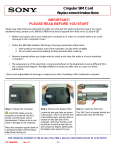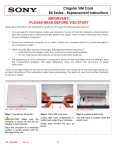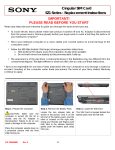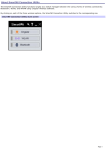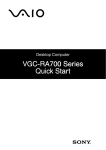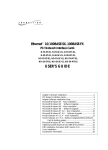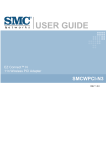Download Sony VGN-T300 User's Manual
Transcript
Personal Computer VGN-T300 Series SmartWi Connection Utility Guide VAIO® Computer Wireless Information Table of Contents About your Computer........................................... 3 Contents .................................................................................... 3 About Wireless Connectivity .................................................... 4 About the SIM Card.................................................................. 4 About Wireless Connection Utility...................... 8 Starting SmartWi Connection Utility........................................ 8 About the Wireless Switching Window ............ 11 Using the Wireless Switching Window .................................. 11 Using SmartWi Connection Utility .................... 12 Using the Cingular WWAN connection ................................. 12 Using the Wireless LAN connection ...................................... 14 Using the Bluetooth® connection........................................... 19 General Functional Information ........................ 21 FAQ and Troubleshooting ................................. 22 Notice to Users ................................................... 32 2 About your Computer About your Computer Thank you for purchasing a VAIO® VGN-T300 Series computer! Your new machine combines state-of-the-art hardware and software to bring you unparalleled wireless connectivity. Contents These hardware components are included. Carton Contents Computer* Battery AC adapter Power cord * A Cingular SIM card is preinstalled in your computer. 3 VAIO® Computer Wireless Information About Wireless Connectivity With built-in Wireless WAN capabilities, your computer is equipped to connect wirelessly to your e-mail, the Internet, and any intranet networks with which you may be associated. To begin making use of wireless connectivity, you will need to insert a provided Subscriber Identity Module (SIM) card into the computer before turning on your computer. About the Cingular SIM Card The SIM card, provided by Cingular Wireless, is a small printed circuit board that stores data identifying the user to the network service provider. It must be inserted into the computer for you to make use of the wireless services. ✍ Only the Cingular SIM card is supported. It is normally preinstalled in your computer. Inserting the Cingular SIM card The Cingular SIM card should be preinstalled; you may follow these procedures to verify that the SIM card is indeed installed in the SIM card slot at the rear of your computer. Do not touch the SIM card connectors. As a precaution, always make sure you have a firm hold of your computer before inserting or removing the SIM card. 4 About the Cingular SIM Card 1 Unless preinstalled, your SIM card is contained within a larger card, about the size of a credit card. Remove the smaller SIM card by pushing it out from the larger card. Cingular SIM Card 2 Next, orient your computer so you are facing its rear portion. ✍ Before inserting the SIM card into the computer, make sure your computer is turned off and the battery is not attached. 3 Locate the SIM card slot in the back of the computer and with its printed circuit side facing down, gently insert the SIM card into the slot. Check the SIM card for directions on which way to orient the card into the slot. 5 VAIO® Computer Wireless Information Inserting the SIM card Cut-off corner oriented left SIM card (printed circuit side face down) If your computer came with a preinstalled Cingular SIM card, verify that the card is indeed in the SIM card slot. ✍ To activate your Cingular account, call Sony customer support at 888-604-VAIO (8246). When calling customer support, you may be asked for the SIM# (IMSI #) and IMEI code. To determine these values, start the Cingular Connection Manager (CCM), open Tools, and click Network Info. Alternatively, you can check the the rear of your VAIO computer. The IMEI # should be printed on the back of your computer. The SIM# is printed on the SIM card. 6 About the Cingular SIM Card Removing the SIM Card Do not touch the SIM card connectors. As a precaution, make sure you have a firm hold of your computer before inserting or removing the SIM card. To remove the SIM card, again orient your computer so you are facing its rear portion. Make sure the computer is turned off. 1 Locate the SIM card slot. 2 Gently push in the SIM card until you hear it click, then release the card allowing the SIM card to eject. After the SIM card ejects, gently pull the card out of the slot, away from the computer. Removing the SIM Card ✍ Take care not to damage the card in any way, either by bending or putting undue pressure on the card. 7 VAIO® Computer Wireless Information About SmartWi Connection Utility The SmartWi Connection Utility functions largely as a switch manager between the various forms of wireless connectivity: Bluetooth®, WLAN, and WWAN using Cingular Wireless software. By clicking on each of the three wireless options, the SmartWi Connection Utility switches to the corresponding one. SmartWi Connection Utility main screen Starting SmartWi Connection Utility At initial statup, a pop-up prompt appears from the Task Tray. Selecting Yes on the prompt launches the SmartWi Connection Utility, and then you are prompted to activate your Cingular account. If you close the program, however, and later wish to restart it, do the following: 8 Starting SmartWi Connection Utility 1 First make sure your computer is turned on. 2 Make sure the wireless switch is turned on. If it is not, locate the switch on the front left portion of your computer and slide the switch to the right. Wireless switch and indicators WWAN W LAN W WAN W LAN ✍ Once you turn on the wireless switch, the SmartWi Connection Utility window appears automatically. 3 You may also click the SmartWi Connection Utility icon in the taskbar notification area. Depending on the wireless selection, one of sixicons may appear in the taskbar notification area. 9 VAIO® Computer Wireless Information SmartWi Connection Utility icons Bluetooth WWAN WWAN and Bluetooth WLAN WLAN and Bluetooth Wireless device is turned off (no WWAN or WLAN) ✍ Note that WWAN and WLAN cannot coexist simultaneously. When one is selected, the other is automatically deselected. 4 Alternately, press Start, select All Programs, select the VAIO SmartWi Connection Utility folder, and click VAIO SmartWi Connection Utility. The SmartWi Connection Utility dialog box displays. 10 About the Wireless Switching Window About the Wireless Switching Window The Wireless Switching Window is another utility that enables switching between wireless modes. It promotes ease of use by allowing you to switch between Bluetooth®, WLAN, and WWAN simply by pressing keyboard buttons instead of using the touch pad (or a separately available USB mouse). Using the Wireless Switching Window To start the Wireless Switching Window in order to switch between wireless modes, simply press Fn + F1 to bring up the window. Then hold the Fn key down while pressing the F1 key to toggle between modes. Wireless Switching Window 11 VAIO® Computer Wireless Information Using Wireless Connection Utility To use the wireless connectivity features and begin using e-mail or connecting to the Internet, simply click the desired button: Cingular Wireless (for WAN connectivity), WLAN, or Bluetooth®. Wireless Connection Utility main screen 12 Using the Cingular Wireless WAN connection Using the Cingular Wireless WAN connection To use Cingular WAN connectivity, do the following: 1 Click the Cingular button on the SmartWi Connection Utility main screen. A Cingular Connection Manager launch area display appears below the button. Cingular Connection Manager launch area 13 VAIO® Computer Wireless Information 2 Click anywhere in the Cingular Connection Manager launch area. The Cingular Connection Manager window displays. Cingular Connection Manager main screen 3 By default, your connection to Cingular service initiates. 4 Follow any additional directions on the Cingular Connection Manager window displays. ✍ For help, click the Help drop-down menu and click Help to display the Cingular Connection Manager help file. Using the Wireless LAN connection To use Wireless LAN (WLAN) connectivity, do the following: 1 Click the WLAN button on the SmartWi Connection Utility main window. A status display appears below the button. 2 Next, click the status display below the WLAN button. The window enlarges to display WLAN Settings. ✍ If it is the first time connect with WLAN, the Wireless Help Utility will launch automatically and guide you during initial setup. 14 Using the Wireless LAN connection WLAN Settings dialog box To deactivate WLAN connectivity, select Disable for the Status field drop-down box on the WLAN Settings dialog. By default, WLAN uses theIEEE802.11b/g standard technology for WLAN connectivity. The standard includes the Wired Equivalent Privacy (WEP) encryption method, which is a security protocol and WiFi Protected Access. To use IEEE802.11b or IEEE802.11g WLAN connectivity standard only, select them from the Mode field drop-down box. ✍ Wireless LAN devices using the IEEE802.11a standard and the ones using the IEEE802.11b or g standard cannot communicate because the frequencies are different. Wireless LAN devices using the IEEE802.11g standard can only communicate with a device using the IEEE802.11b standard, not with the IEEE802.11a standard. ✍ IEEE802.11b: The standard speed is 11 Mbps, or about 30 to 100 times faster than a standard dial up. ✍ IEEE802.11g: The standard speed is 54 Mbps, or about 5 times faster than a Wireless LAN device using the IEEE802.11b standard. 15 VAIO® Computer Wireless Information Configuring the WLAN connection You can configure your computer to connect to a WLAN in one of two of the following ways: ❑ without an access point device (ad-hoc) ❑ with an acces point device An ad-hoc network is a network in which a local network is created only by the wireless devices themselves, with no other central controller or access point device. Each device communicates directly with other devices in the network. For example, you can set up an ad-hoc network easily at home to communicate between two computers. A computer communicationg with an access point device is configured as part of an infrastructure network. An infrastructure network is a network that extends an existing wired local network to wireless devices by providing an Access Point, for example the Sony Access Point. The Access Point bridges the wireless and wired LAN and acts as a central controller for the Wireless LAN. The Access Point coordinates transmission and reception from multiple wireless devices within a specific range. ❑ 16 To configure your computer to communicate without an access point device (ad-hoc), follow these steps: 1 On the WLAN Settings dialog box, click the Configure WLAN button. The Wireless Network Connection Properties window displays. 2 If not automatically selected, select the Wireless Networks tab. 3 Click the Add... button. The Association tab opens in the Wireless network properties window. 4 Enter a Network name (SSID). You can choose a 32-digit alphanumeric name. If you want to communicate between two or more computers, you need to configure all these computers using the same network name. 5 Select Open from the Network Authentication drop-down box. 6 Select WEP from the Data Encryption drop-down box. Using the Wireless LAN connection 7 Deselect the The key is provided for me automatically option button. The Network key, Confirm network key, and Key index (advanced) fieldss activate. 8 Enter the Network key. The network key should be 5 or 13 alphanumeric characters long. You can choose whatever you want. If you want to communicate between two or more computers, you need to configure all these computers using the same network key. 9 Enter exactly the same Network key again, for confirmation. 10 Select the check box This is a computer-to-computer (ad hoc) network; wireless access points are not used. 11 Click OK. Your Network name appears in the Preferred networks area in the Wireless Networks tab display. 12 Click Advanced. The Advanced window displays. 13 Select the Computer-to-computer (ad hoc) networks only option button. 14 Click Close. 15 Click OK. Your computer is ready to communicate with another computer. To disconnect from a computer-to-computer (ad-hoc) network, click Configure WLAN on the WLAN Settings dialog box, select the Network Name in the Preferred netowks area, click Remove, and then click OK. ❑ To configure your computer to communicate with an access point device, follow these steps: ✍ Use the VAIO Wireless Utility to guide you through the set up process and provide you with more detailed information about wireless connections. 1 Make sure an access point is set up. See the instructions that accompanied the access point for more information. 2 Click Start, point to All Programs, and click VAIO Wireless Utility. The VAIO Wireless Utility displays. 3 Follow the on-screen instructions. 17 VAIO® Computer Wireless Information Configuring Proxy and IP Settings for WLAN connections You can configure Proxy and IP Settings for use in connecting to your WLAN network. To do this: 1 From the WLAN Settings dialog box, click Advanced Settings. The Advanced Settings window displays. 2 Select a network profile from the list that you want to configure, and then click Edit. ❑ To configure your Proxy, follow these steps: 1 On the Proxy tab, select whether to use the Internet Explorer proxy settings or not, or to use a proxy server of yourr choice for your WLAN connection. If you want to use a specified proxy server, you must identify its address and port. 2 ❑ Click Apply and proceed to configure IP Settings or click OK. To configure your IP Settings: 1 On the IP Settings tab, select whether to obtain IP and DNS server address automatically or not. If you do not want to obtain IP automatically, you must identify the IP address, subnet mask, and default gateway addresses, and identify preferred and alternate DNS servers. Optonally, you can select to obtain IP automatically and choose to specify preferred and alternate DNS servers. 2 3 Click Apply and proceed to configure a Proxy or click,OK. Click Close to close the Advanced Settings window. 18 Using the Bluetooth® connection Using the Bluetooth® connection To use Bluetooth® technology connectivity, do the following: 1 Click the Bluetooth button on the Wireless Connection Utility dialog box. This activates Bluetooth® technology, and a status display appears below the button. 2 Next, click the status display below the Bluetooth button. The window enlarges to display Bluetooth Settings. Bluetooth Settings dialog box 3 Click the Bluetooth Devices button. The Bluetooth Devices dialog box displays. 19 VAIO® Computer Wireless Information Bluetooth Devices dialog box 4 From the Bluetooth Devices dialog box, select and search for any Bluetooth® devices in the vicinity of your computer. Click Add to invoke the Add Bluetooth Device Wizard and follow the onscreen instructions. When completed, click OK. 20 General Functional Information General Functional Information SmartWi Connetion Utility supports the following Wireless WAN-related funtionality: ❑ Network Systems GSM 850, 1800, and 1900 ❑ Network Services GPRS/EDGE and SMS Note: Speech services are not supported ❑ SIM Card Small plug-in card, XX-type with SIM lock Note: The supplied Cingular SIM card is the only SIM card supported. ❑ Speed Maximum continuous speed and FTP download speeds to 160 kbytes or more. ❑ Interface Type Internal USB ❑ Connection Type PPP connection across USB ❑ Communication Port Virtual communications on COM port 5 Software Upgrades You can upgrade your PC Card firmware/software from the Internet website http://esupport.sony.com. 21 VAIO® Computer Wireless Information FAQ and Troubleshooting This section provides answers to frequently asked questions (FAQ) and possible operating workaround information for the SmartWi Connection Utility (SWCU). In addition, this information can help to clarify issues encountered when using the SmartWi, Cingular Connection Manager and its associated features. Answers to Frequently Asked Questions ❑ General Question: What is the SmartWi Connection Utility? Answer: SWCU is a wireless connection utility application that is designed to switch and manage wireless connection modes between Bluetooth, 802.11, and Cingular GPRS/EDGE. Question: Can I connect to two separate types of wireless connections simultaneously (for example, GPRS and 802.11b/g)? Answer: No. Connections are mutually exclusive, with the exception of Bluetooth which will run concurrently with other wireless connections. Bluetooth can be switched on and off via the software without causing interference to the current connection (for example, GPRS or 802.11b/g). The hardware indicator/switch for the wireless devices is located at the front panel on the left side. Question: Are 802.11a (5GHz) WLAN connections supported under SWCU? Answer: No, only 802.11b and 802.11g (2.4GHz) connection types are supported. In the future, 802.11a may become available. 22 Answers to Frequently Asked Questions ❑ SWCU Operation Question: Why do I get a VAIO Wireless Help Utility prompted when launching WLAN? Answer: If there is not any WLAN profile configured previously (this is the first time using WLAN), the VAIO Wireless Help Utility will be launched automatically, or the VAIO Wireless Help Utility loads when it detects a failure in interfacing with the driver. To remedy the problem, follow the suggestions from the assist help section. Question: I clicked the “Show All Prompts” button for the Reset all messages feature, but nothing seemed to happen. What happened when I clicked this button? Answer: Clicking the Show All Prompts button for the Reset all messages feature activates all the prompts (not options) that request the “Don’t ask me again” action. Normally, when notifications appear from yes/no prompts you can select if you do not want to be asked again for the notifications by checking the “Don’t ask me again” check box. The “Reset all messages” feature provides a way to clear all the checkboxes from all the prompts simultaneously. As a result, the prompts will display again. The following figure is an example of a prompt that would display after clicking clicking the Show All Prompts button. Show All Prompts action example Question: Why isn’t there support for “Hotkeys” to maneuver within SWCU? Answer: The hotkeys feature will be incorporated into future SWCU versions. 23 VAIO® Computer Wireless Information Question: I clicked on the SmartWi minimize option and noticed the minimized icon was not in the taskbar. Where is the minimized application and how do I bring back the application to the desktop? Answer: The SmartWi application was minimized into the Task-tray, which shows the “SWCU” icon and not into the “Taskbar”. Depending on the type of connection and combination, if any, the SWCU icon will reflect the current connection. For example, if the SmartWi connects simultaneously with the Bluetooth device, the icon will reflect the connection type with a Bluetooth emblem. Switching on and off the Bluetooth option does not interfere with WiFi or WWAN connection. To bring forward the SmartWi application to the desktop, click the SmartWi icon from the task-tray once (see the following illustration) or navigate to Start --> All Programs --> SmartWi Connection Utility, and then click the SmartWi Connection Utility icon. Minimized WWAN and Bluetooth connection icon Question: Why do I not have an option to delete WLAN profiles from the SmartWi WLAN profiles list in the Advanced Settings window? Answer: Profiles can be managed and edited via SmartWi, but cannot be deleted. Profiles can be deleted from Windows Wireless Network Connection Properties window that displays when clicking Confugure WLAN on the SmartWi WLAN Settings dialog box. Question: I noticed that if I open a WLAN connection from SmartWi, sometimes the WLAN profile in Windows Wireless Network Connection window shows “Not connected”. But actually the connection is established. Answer: Under the Windows Wireless Network Connection window, click on the “Refresh network list” located under “Network Tasks”. This should refresh Windows and provide an accurate overview of wireless status. If this is not fixed the problem, then close the Windows Wireless Network Connection window and re-launch it from Windows network connections. 24 Answers to Frequently Asked Questions ❑ Cingular Connection Manager (CMM) Question: What does it mean to “Restore” from the tool help bubble? Answer: Clicking the “mini bar” option once, reduces the full details to a “mini bar”. Click the “Restore” option to return to full details view. Question: Why does the “Connection Log” not sort when clicking on the columns title bar? Answer: This feature will be available in future versions. Sorting by type, technology, date/time, duration total bytes and description should be available in future versions. Question: Why do I see “Device not detected” in the Cingular Connection Manager details window? Answer: This is most likely to occur while switching from WWAN to launching CCM. There is a slight timing degradation that occurs while making the switch which causes this status. Turn off the WWAN and then reconnect the WWAN to fix the problem. Question: CCM sometimes fails to respond after resuming from Suspend mode. What could be the problem? Answer: If the “General” tab under the Edit Profile screen for GSM is left open, this can often keep CCM from reopening upon resuming from suspend mode. Make certain the “Edit Profile” screen has been closed after making any changes. A reboot should correct the problem. Question: When I try to connect through Cingular GPRS network, the Connect/Disconnect button is greyed out, and there is no connection available. Answer: Click on the “Connect Using “tab in CCM, and check one of the connection types from the drop down menu. Close out of CCM and reboot. Question: I noticed an option to create a CSD Accelerated/Non-Accelerated network profile. What is this? Answer: CSD is Circuit Data Network. This is an older technology with lower throughput which has been phased out. We recommend that EDGE/GPRS Acelerated/NonAcelerated profile options be used instead. 25 VAIO® Computer Wireless Information ❑ SMS Question: What does “Load” do and why does it not prompt for options or input? Answer: The SMS help file indicates this is useful in case of accidental deletion of messages. The “Load” feature would be a way to recover the deleted messages, however, this option provides no notification that the task completed successfully. Question: What does “Save” do and why does it not prompt for options or input? Answer: The help file indicates this keeps the current state of all folders, except the inbox. However, no notification is sent indicating the “Save” completed. Question: I copied a message to the “Outbox”. Why does it not prompt to enter the recipient? Answer: Although you can move or copy a message from one folder to another, including the “Outbox”, the message must have a recipient before the message can be sent. If the message is copied and/or moved to the “Outbox”, the message still will not have a recipient, thus leaving the message unable to be sent. This would be considered the same as a the “Forward message” feature. The message would remain in the “Outbox” indefinitely until a destination or destinations are provided. For working around this, we recommend double-clicking on the message, enter a recipient, and then click “Send”. Question: I created an SMS message, but am not connected to GRPS. How is it possible that the message can be sent? Answer: Sending SMS does not need a GPRS data connection. As long as it detects and attaches to the Cingular network, it will able to send SMS. Question: What is, and what does the function button “Update Address Book with Phone Book Contents” do? Answer: When the SIM is installed, it contains a built-in phone book, which when using this feature, allows the contents of the phone book to be incorporated into the address book. 26 Answers to Frequently Asked Questions Question: Why I am not alerted of transferring the contents of phone book to the address book? Answer: This is a feature that is still under development. A request for further study to be conducted with this option has been applied. Question: When I select a message from a folder, and then scroll right, the all previously existing messages appear to be gone if I scroll back to the original folder position. Answer: Click out of the folder, and then back in to refresh the screen. Question: I clicked on the Cingular Connection Manager minimize button and noticed that the CCM icon was not in the taskbar. Where is the minimize icon and how do I bring forth the application to the desktop? Answer: The CCM minimizes into the Task-tray, which is represented by the “Cingular” trademark cross icon and not into the “Taskbar” (see the Cinguler logo illustration below). Depending on the strength of the GPRS signal, the trademark will reflect this with a degree of graduations. In other words, if the signal strength synchronizes to 3 bars (see the Task-tray illustration below), the Cingular trademark cross will show approximately half of trademark cross in the task tray. If the signal strength is one bar, the trademark cross will appear to show a bottom portion of the trademark cross. If the signal strength is at five bars, the entire Cingular trademark cross will be fully indicated. To bring forth the CCM to the desktop, click the Cingular trademark icon in the task-tray or right-click the Cingular trademark cross and select “Show”. Cingular logo trademark cross Minimized Cingular logo trademark cross 27 VAIO® Computer Wireless Information ❑ GPRS Network Question: Why do I see a network connection speed rate of 214.4 Kbs, but when I try to access a website that requires a minimum of 128 Kbs, I am told that I do not have the required inimum rate. Answer: The network speed indicator provides the capacity of the wireless device is 214.4 Kbs but the actual speed depends on network throughput. To work around this, try to change the network settings to optimize the GPRS/EDGE value. This is done by accessing CCM --> Tools --> Settings… --> Advanced Networking, and then selecting “Optimized GPRS/EDGE value” option form the RWIN variables window. Question: I am experiencing dropped connections, slowness, and other difficulties while attempting to stream video over the Cingular GPRS connection. What could be the problem? Answer: Bandwidth over the Cingular GPRS network is somewhat restricted as compared to wired or 802.11x wireless connection types. Due to the demanding nature of streaming audio/video, it is not recommended that GPRS be used for either streaming video, or very large data downloads. Question: I am experiencing difficulty reconnecting to my web browser when switching from the Cingular GPRS network to a WLAN connection. What could be the problem? Answer: The network behind the WLAN’s Access Point may be set up to use a proxy server. If this is the case, proxy settings entered for Internet Explorer over WLAN may prevent IE from connecting over a GPRS link. To allow web browsing from either connection type: 28 1 Correctly configure IE proxy settings for use over the WLAN connection. Then, open the Cingular Connection Manager and rightclick the “GSM” tab. Select “profiles” and then click on the “Edit” button. 2 Under the “General” tab, make certain that the “Disable IE’s manual proxy settings on connect” checkbox has been enabled. Close the “Edit” screen and then close and reopen Internet Explorer. Remember to close and reopen IE each time you switch connection types in order to refresh proxy settings within Internet Explorer. Answers to Frequently Asked Questions 3 If you are still having trouble, contact your network administrator to assist in obtaining the proxy settings. Question: I am seeing a message in Windows taskbar stating; “GPRS a Network Cable is Unplugged”. What does this mean? Answer: Typically, this message appears if your VAIO PC is connected to the Cingular GPRS network and is allowed to go into hibernation. Upon resuming, Cingular has terminated the connection. However, Windows information has not yet been updated to recognize this change and is unaware that your GPRS connection does not require a cable. You may either re-connect to Cingular, or simply cancel out of the message. Question: Downloads sometimes appear to be slow when connecting to the Internet via CCM. What type of download speeds should I expect? Answer: Since CCM operates over a cellular network and is subject to the same issues/conditions as cellular connections, bandwidth may vary greatly. Common download speeds ranging from 18~64Kbps are possible with 30~36Kbps rates as typical. However, these are only estimates and your actual experience will likely vary depending upon a number of environmental factors. Question: What is meant by “RWIN” from the CCM Tools settings advanced networking section? Answer: The TCP Receive Window size is the amount of ‘receive’ data (in bytes) that can be buffered at one time on a connection. RWIN (TCP Receive Window) can be changed using the method of setting up the variables to optimize TCP. We recommend that this setting not be changed unless you are an expert or you have explicit instructions from your network administrator. Note: Changing the settings for this value also has an effect when using WLAN device or any device that depends on TCP connection. ❑ Sonic Stage/Music Store Question: I am unable to stream audio from some web sites such as inamp© , Shoutcast©, etc. using Sonic Stage? Why is this the case? Answer: Many of these web sites use proprietary players and use encoding formats that are not supported by other players. You can download one of these players if you wish, or try streaming from Sony Connect™ Music 29 VAIO® Computer Wireless Information Store using Sonic Stage. Question: Sonic stage appears to lock up indefinitely (displays a spinning ‘LOADING’ logo) when attempting selecting “Radio Connect” (streaming) from Sony Connect™ site. Answer: This is related to the issue of streaming audio over low bandwidth connections as referenced above under “GPRS Networking”. Connecting to Music Store over a wired or broadband connection will usually resolve this issue. ❑ Bluetooth Question: Why do I not see the Bluetooth device that is connected to the computer from the BT connected device status box of the SmartWi Connection Utility? Answer: It is most likely no Bluetooth devices have been configured for the system. Bluetooth devices are not configured automatically. To install or configure Bluetooth devices, you will need assistance in setting up the Bluetooth device on the computer. Follow steps from the help section of installing the Bluetooth device. We recommend obtaining the latest Bluetooth drivers. Question: I can not connect to my Bluetooth keyboard (or other device). What could be the problem? Answer: You will need to make certain that you are using the most current drivers available for your Bluetooth device. Try reinstalling under the updated driver per the manufacturers instructions. ❑ Uninstall, Reinstall and Repair Question: How do I uninstall the SmartWi application and all its associated modules? Answer: There are several components that should be uninstalled when removing the SmartWi application. The following steps should be observed while uninstalling the SmartWi application 1 Uninstall Wireless Switch Setting Utility 2 Uninstall Sony Utilities DLL When prompted, restart the computer. 3 30 Uninstall VDC driver using the driver Answers to Frequently Asked Questions 4 Uninstall Sony Utilities 5.3.0.1130 5 Uninstall VAIO Wireless Utility 6 Uninstall Cingular Connection Manager 7 Uninstall SmartWi connection Utility Question: I do not see a repair option for the SmartWi from the control panel. How do I repair the SmartWi and its associated modules? Answer: At this time there is no “Repair” option for the SmartWi and associated modules. To work around this, we recommend to uninstall SmartWi and the associated modules and then reinstall. Question: If I uninstall and then reinstall the Cingular Connection Manager application, will the application lose the messages and phone book? Answer: Uninstalling the Cingular Connection Manager application will not remove your messages or the phone book. After reinstallation has been completed, you are prompted to launch CCM and view the readme.html file. Click OK to launch CCM. Load SMS and advance to messages. Observe that the messages remain. Load the phone book, and notice that the contacts remain. 31 VAIO® Computer Wireless Information Notice to Users © 2005 Sony Electronics Inc. Reproduction in whole or in part without written permission is prohibited. All rights reserved. This manual and the software described herein, in whole or in part, may not be reproduced, translated, or reduced to any machine-readable form without prior written approval. SONY ELECTRONICS INC. PROVIDES NO WARRANTY WITH REGARD TO THIS MANUAL, THE SOFTWARE, OR OTHER INFORMATION CONTAINED HEREIN AND HEREBY EXPRESSLY DISCLAIMS ANY IMPLIED WARRANTIES OF MERCHANTABILITY OR FITNESS FOR ANY PARTICULAR PURPOSE WITH REGARD TO THIS MANUAL, THE SOFTWARE, OR SUCH OTHER INFORMATION. IN NO EVENT SHALL SONY ELECTRONICS INC. BE LIABLE FOR ANY INCIDENTAL, CONSEQUENTIAL, OR SPECIAL DAMAGES, WHETHER BASED ON TORT, CONTRACT, OR OTHERWISE, ARISING OUT OF OR IN CONNECTION WITH THIS MANUAL, THE SOFTWARE, OR OTHER INFORMATION CONTAINED HEREIN OR THE USE THEREOF. SONY CANNOT WARRANT THAT THE FUNCTIONS DESCRIBED IN THIS GUIDE WILL BE UNINTERRUPTED OR ERROR-FREE. SONY ALSO ASSUMES NO RESPONSIBILITY, AND SHALL NOT BE LIABLE FOR ANY DAMAGES TO, OR VIRUSES THAT MAY INFECT, YOUR COMPUTER EQUIPMENT, OR OTHER PROPERTY ON ACCOUNT OF YOUR ACCESS TO, USE OF, OR BROWSING IN ANY DESCRIBED WEB SITE, OR YOUR DOWNLOADING OF ANY MATERIALS, DATA, TEXT, IMAGES, VIDEO, OR AUDIO FROM ANY DESCRIBED WEB SITE. WEB SITE INFORMATION IS OBTAINED FROM VARIOUS SOURCES AND MAY BE INACCURATE. COPIES OF COPYRIGHTED INFORMATION MAY ONLY BE MADE FOR LEGALLY PERMISSIBLE PURPOSES. Sony Electronics Inc. reserves the right to make any modification to this manual or the information contained herein at any time without notice. The software described herein is governed by the terms of a separate user license agreement. This product contains software owned by Sony and licensed by third parties. Use of such software is subject to the terms and conditions of license agreements enclosed with this product. Some of the software may not be transported or used outside the United States. Software specifications are subject to change without notice and may not necessarily be identical to current retail versions. Certain product(s) included with this computer may include features such as copy protection and content management technology. USE OF THE SOFTWARE PRODUCT(S) REQUIRES AGREEMENT TO APPLICABLE END USER AGREEMENTS AND FULL COMPLIANCE WITH APPLICABLE PRODUCT ACTIVATION PROCEDURES. Product activation procedures and privacy policies will be detailed during initial launch of the software product(s), or upon certain reinstallations of the software product(s), or reconfigurations of the computer, and may be completed by Internet or telephone (toll charges may apply). Updates and additions to software may require an additional charge. Subscriptions to online service providers may require a fee and credit card information. Financial services may require prior arrangements with participating financial institutions. Important information for Canadian customers: Your new VAIO computer includes certain software versions or upgrades, and Internet services or offers that are available to U.S. customers only. Sony, VAIO, the VAIO logo, VAIO Digital Studio, VAIO Media, VAIO Media Music Server, VAIO Media Photo Server, VAIO Media Video Server, Click to DVD, CLIÉ, DVgate Plus, Handycam, MagicGate, Memory Stick, the Memory Stick logo, OpenMG, MICROMV, SonicStage, PictureGear, ImageStation, ATRAC3, and i.LINK are trademarks or registered trademarks of Sony. Intel and Pentium are trademarks or registered trademarks of the Intel Corporation. Microsoft, Windows, and the Windows logo are trademarks or registered trademarks of the Microsoft Corporation. PS/2 is a registered trademark of the IBM Corporation. All other trademarks are trademarks or registered trademarks of their respective owners. 32 Notice to Users Regulatory Information Declaration of Conformity Trade Name: Sony Model No.: PCG-4E1L Responsible Party: Sony Electronics Inc. Address: 16450 W. Bernardo Dr., San Diego, CA 92127, USA Telephone: (For FCC-related matters only.) 858-942-2230 This device complies with Part 15 of the FCC rules. Operation is subject to the following two conditions: (1) This device may not cause harmful interference, and (2) this device must accept any interference received, including interference that may cause undesired operation. FCC information This equipment has been tested and found to comply with the limits for a Class B digital device, pursuant to Part 15 of the FCC Rules. These limits are designed to provide reasonable protection against harmful interference in a residential installation. This equipment generates, uses, and can radiate radio frequency energy and, if not installed and used in accordance with the instructions, may cause harmful interference to radio communications. However, there is no guarantee that interference will not occur in a particular installation. If this equipment does cause harmful interference to radio or television reception, which can be determined by turning the equipment off and on, the user is encouraged to try to correct the interference by one or more of the following measures: ❑ Reorient or relocate the receiving antenna. ❑ Increase the separation between the equipment and the receiver. ❑ Connect the equipment into an outlet on a circuit different from that to which the receiver is connected. ❑ Consult the dealer or an experienced radio/TV technician for help. You are cautioned that any changes or modifications not expressly approved in this manual could void your authority to operate this equipment. Only peripherals (computer input/output devices, terminals, printers, etc.) that comply with FCC Class B limits may be attached to this computer product. Operation with noncompliant peripherals is likely to result in interference to radio and television reception. All cables used to connect peripherals must be shielded and grounded. Operation with cables, connected to peripherals, that are not shielded and grounded, may result in interference to radio and television reception. FCC Part 68 This equipment complies with Part 68 of the FCC rules and the requirements adopted by the ACTA. On the modem card is a label that contains, among other information, a product identifier in the format US:AAAEQ##TXXXX. If requested, this number must be provided to the telephone company. This modem uses the USOC RJ-11 telephone jack. A telephone plug and jack used to connect this equipment to the premises wiring and telephone network must comply with the applicable FCC Part 68 rules and requirements adopted by the ACTA. The REN is used to determine the quantity of devices which may be connected to the telephone line. Excessive RENs on the telephone line may result in the devices not ringing in response to an incoming call. In most, but not all areas, the sum of the RENs should not exceed five (5.0). To be certain of the number of devices that may 33 VAIO® Computer Wireless Information be connected to the line, as determined by the total RENs, contact the telephone company. For products approved after July 23, 2001, the REN for this product is part of the product identifier that has the format US:AAAEQ##TXXXX. The digits represented by ## are the REN without a decimal point (e.g. 03 is a REN of 0.3). For earlier products, the REN is separately shown on the label. If this equipment causes harm to the telephone network, the telephone company will notify you in advance that temporary discontinuance of service may be required. But if advance notice is not practical, the telephone company will notify the customer as soon as possible. Also, you will be advised of your right to file a complaint with the FCC if you believe it is necessary. The telephone company may make changes in its facilities, equipment, operations or procedures that could affect the operations of the equipment. If this happens, the telephone company will provide advance notice in order for you to make the necessary modifications in order to maintain uninterrupted service. If trouble is experienced with this equipment, for repair or warranty information, please contact the Sony Customer Information Service Center at 1-888-4-SONY-PC (1-888-476-6972), or write to the Sony Customer Information Center, 12451 Gateway Blvd., Fort Myers, FL 33913, USA, or find Sony Customer Service on the Web at http://www.sony.com/pcsupport. If this equipment is causing harm to the telephone network, the telephone company may request that you disconnect the equipment from the network until the problem is resolved. Repair of this equipment should be made only by a Sony Service Center or Sony authorized agent. For the Sony Service Center nearest you, call 1-888-4-SONY-PC (1-888-476-6972), or visit the Sony Online Support Web site at http://www.sony.com/pcsupport. Connection to Party Line Service is subject to state tariffs. Contact the state public utility commission, public service commission, or corporation commission for information. If your home has specially wired alarm equipment connected to the telephone line, ensure the installation of this equipment does not disable your alarm equipment. If you have questions about what will disable alarm equipment, consult your telephone company or a qualified installer. Please use a surge arrestor against electrical surges. FCC Radio Frequency Exposure (United States)* and SAR The available scientific evidence does not show that any health problems are associated with using low power wireless devices. There is no proof, however, that these low power wireless devices are absolutely safe. Low power wireless devices emit low levels of radio frequency energy (RF) in the microwave range while being used. Whereas high levels of RF can produce health effects (by heating tissue), exposure to low level RF that does not produce heating effects causes no known adverse health effects. Governments around the world have adopted comprehensive international safety guidelines, developed by scientific organizations, e.g ICNIRP (International Commission on Non-Ionizing Radiations Protection) and IEEE (The Institute of Electrical and Electronics Engineering Inc.), through periodic and thorough evaluation of scientific studies. These guidelines establish permitted levels of radio wave exposure of the general population. The levels include a safety margin designed to assure the safety of all persons, regardless of age and health, and to account for any variations in measurements. Specific Absorption Rate (SAR) is the unit of measurement for the amount of radio frequency energy absorbed by the body when using a transceiver. The SAR value is determined at the highest certified power level in laboratory conditions, but the actual SAR level of the transceiver while operating can be well below this value. This is because the transceiver is designed to use the minimum power required to reach the network. Variations in SAR below the radio frequency exposure guidelines do not mean that there are variations in safety. While there may be differences in SAR levels among mobile phones, VAIO PC is degined to meet radio frequency exposure guidelines. Before VAIO PC is available for sale to the public, it must be tested and certified to the FCC that is does not exceed the limit established by government-adopted requirement for safe exposure. The test are performed in positions and locations as required by the FCC for each model. For body worn operations, this PC has been tested and meets FCC FR exposure guidelines for fixed and mobile use as normal PC use. SONY has not measured and makes no representation about, the body worn SAR levels when any changes to the original product. (For PCG-4E1L models with wireless LAN and wireless WAN) The personal computer (PCG-4E1L) has been tested and found to comply with the Federal Communications Commission (FCC) guidelines on radio frequency energy (RF) exposures. The maximum SAR levels tested for the personal computer (PCG-4E1L) has been shown to be 0.266 w/kg (16.625%) when 1900 band and BT are transmitting simultaneously. * For models with wireless LAN functionalities. 34 Notice to Users The PCG-4E1L notebook computer contains a Wireless LAN or Wireless WAN transmitter which is co-located and operating simultaneously with a 0.09 mW Bluetooth module. This device and its antenna(s) must not be co-located or operating with any other antenna or transmitter except Grant condition. Users are not permitted to modify this transmitter device. Any unauthorized change made to this device could void your authority to operate this device. (Wireless WAN and Wireless LAN transmitter do not operate simultaneously.) Personal Medical Devices When Wireless WAN (EDGE module) power is on the transmitting, it may affect the operation of cardiac pacemakers and other implanted equipment. If a minimum distance of 15 cm (6 inches) is kept between the PC and the pacemaker, the risk of interference is limited. If you have any reason to suspect that interference is taking place, immediately turn off WAN feature. Contact your cardiologist for more information. For other medical devices, please consult the manufacture of the device. Emergency Calls EDGE module that is embedded to SONY VAIO do not support voice calls, hence their use for essential communication is not possible. Inserting and removing the SIM card – precautions against electrostatic discharges (ESD) Do not touch the SIM card connectors. As a precaution, always make sure that VAIO PC is in your hand before you insert or remove the SIM card. IC RSS-210 (Canada) Operation is subject to the following two conditions: (1) this device may not cause interference, and (2) this device must accept any interference, including interference that may cause undesired operation of the device. To prevent radio interference to the licensed service, this device is intended to be operated indoors and away from windows to provide maximum shielding. Equipment (or its transmit antenna) that is installed outdoors is subject to licensing. The term “IC:” before the certification/registration number only signifies that the Industry Canada technical specifications were met. Sony is not responsible for any interference that you may experience or that may be caused when operating this device. L’utilisation de ce dispositif est autorisée seulement aux conditions suivantes: (1) il ne doit pas produire de brouillage et (2) l’utilisateur du dispositif doit être prêt à accepter tout brouillage radioélectrique reçu, même si ce brouillage est susceptible de compromettre le fonctionnement du dispositif. Pour empêcher que cet appareil cause du brouillage au service faisant l’objet d’une licence, il doit être utilisé à l’interieur et devrait être placé loin des fenêtres afin de fournir un écran de blindage maximal. Si le matériel (ou son antenne d’émission) est installé a l’exterieur, il doit faire l’objet d’une licence. L’expression “IC:” avant le numéro d’homologation/enregistrement signifie seulement que les spécifications techniques d’Industrie Canada ont été respectées. Sony n'est pas responsable des interférences que vous risquez de rencontrer ou qui risquent d'être provoquées lors du fonctionnement de cet appareil. 35 VAIO® Computer Wireless Information IC Exposure of Humans to RF Fields The installer of this radio equipment must ensure that the antenna is located or pointed such that it does not emit RF field in excess of Health Canada limits for the general population; consult Safety Code 6, obtainable from Health Canada’s website: www.hc-sc.gc.ca/rpb. L’installateur du present materiel radio doit s’assurer que l’antenne est situee ou pointee de maniere a ce que cette derniere n’emette pas de champs radioelectriques superieurs aux limites specifiees par Sante Canada pour le grand public; consulter le Code de securite 6, disponible sur le site Web de Sante Canada, a l’adresse suivante: www.hc-sc.gc.ca/rpb. Telephone Consumer Protection Act of 1991 (United States) The Telephone Consumer Protection Act of 1991 makes it unlawful for any person to use a computer or other electronic device, including FAX machines, to send any message unless such message clearly contains, in a margin at the top or bottom of each transmitted page or on the first page of the transmission, the date and time it is sent and an identification of the business, other entity, or individual sending the message, and the telephone number of the sending machine or such business, other entity, or individual. (The telephone number provided may not be a 900 number or any other number for which charges exceed local or long distance transmission charges.) In order to program this information into your facsimile machine, see your fax software documentation. Telephone Consumer Guidelines (Canada) Please refer to your telephone directory under ‘Privacy Issues’ and/or ‘Terms of Service.’ For more detailed information, please contact: CRTC Terrasses de la Chaudiére Tour centrale 1 promenade du Portage 5 étage Hull PQ K1A 0N2. Industry Canada Notice NOTICE: This equipment meets the applicable Industry Canada Terminal Equipment Technical Specifications. The Ringer Equivalence Number (REN) for this terminal equipment is 0.2. The REN assigned to each terminal equipment provides an indication of the maximum number of devices allowed to be connected to a telephone interface. The termination on an interface may consist of any combination of devices subject only to the requirement that the sum of the RENs of all the devices does not exceed 5. This Class B digital apparatus complies with Canadian ICES-003. Cet appareil numerique de la classe B est conforme a la norme NMB-003 du Canada Avis de L’Industrie Canada REMARQUE: Cet équipement est conforme aux Spécifications Techniques des Équipements Terminaux d’Industrie Canada en vigueur. Le Nombre Équivalent de Sonneries (REN) de cet équipement terminal est 0,2. Le REN attribué à chaque équipement terminal indique le nombre maximum de terminaux que l’on peut connecter à une interface téléphonique. La terminaison d’une interface peut consister en une combinaison quelconque de dispositifs, à la seule condition que la somme d’indices d’équivalence de la sonnerie de tous les dispositifs n’excède pas 5. 36 For customer support information, go to: http://www.sony.com/pcsupport VAIO Homepage http://www.vaio.net © 2005 Sony Electronics Inc.






































